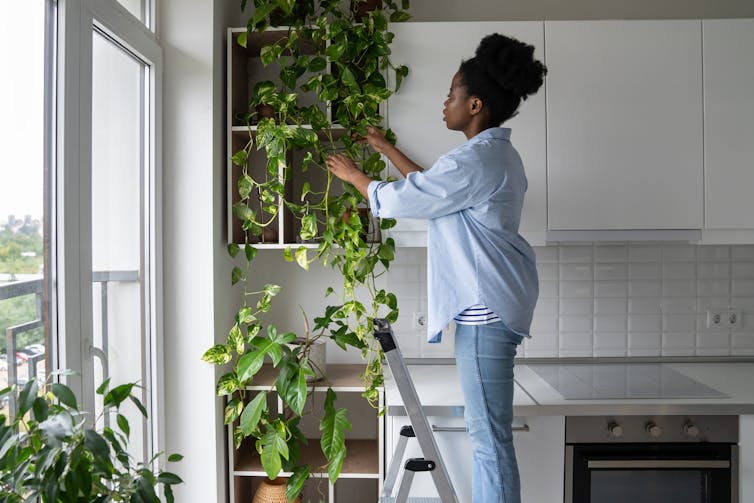In recent years, we have seen growing interest in houseplants, particularly among younger generations. Between 2019 and 2022, houseplant sales in the UK increased by more than 50%. Indoor plants are associated with a range of environmental and health benefits including cleaner air, better mental health and clearer thinking.
If you’re a plant parent, you probably know that plants need food and water to grow and survive. You will also know that plants have roots for taking these resources in and leaves to absorb the light energy required for photosynthesis. This sounds simple, but many of us (including me) struggle to keep our plants healthy.
Many common houseplants, especially those in the aroid family like the monstera (or the Swiss cheese plant) and philodendron evolved in tough conditions. In their tropical or subtropical forest homes, these plants begin life on the ground but quickly climb the nearest tree to escape the dimly lit forest floor. They produce aerial roots that grow from stems above the ground and attach the plant to a tree’s trunk, allowing them to climb.
Knowing whether these roots take up nutrients or not will influence how we care for these plants. Currently, people tend to feed them in the soil with regular watering and plant food. So in a recent study, my colleague and I compared aerial and soil-formed roots’ ability to take up nitrogen, an important plant food.
We expected the soil roots to better take up nitrogen because the soil is where the nutrients are – certainly in most houseplant potting mixes. Instead, we found that the aerial roots were far more efficient at taking up nitrogen than their soil counterparts.
Reach for the sky

Pomme Home/Shutterstock
As they climb, aroids grow more leaves. To sustain this growth, the plant will require more nutrients and water. Trees and shrubs effectively meet their demands for food and water by adding new pipes called xylem and phloem to the stem or roots.
The xylem is a tissue that transports water and nutrients upward, from the roots to the leaves. The phloem carries sugars the opposite way.
But monstera and philodendron (and other aroids) are instead related to grasses, meaning they are unable to make new pipes to take up resources. Without help, they would run out of suck – like trying to suck a thick milkshake through a small straw – leaving them unable to feed their increasing leaf area.
Monsteras and philodendrons overcome this problem by growing roots from the new stems as they grow (effectively adding more straws). These new roots grow downwards towards the soil where, in theory, they will take up nutrients and water.
But until now, this theory has not been tested.
Caring for your plants
We grew three common houseplants, a philodendron, an anthurium (flamingo flower) and an epipremnum (devil’s ivy) both in humid conditions where there was plenty of water in the atmosphere, and in conditions typical of an office building (around 45% humidity).
After a few months, we recorded how big the plants were and then measured exactly how much nitrogen was taken up by each type of root.
Nitrogen uptake is measured by using a label – a bit like feeding flowers food dye. Nitrogen is present in nature in two “sizes”, called stable isotopes. The heavy one, nitrogen-15, is far less abundant in nature than the lighter nitrogen-14, so when we fed the roots a solution high in the heavy nitrogen, we were able to measure how much of it was taken up compared to the other nitrogen isotope already in the roots.
To compare soil roots with aerial roots, we then fed the heavy nitrogen solution to individual roots and measured the amount of heavy nitrogen that was taken up by each.
Houseplants with more moisture in the air grew bigger and lost less water from their leaves during photosynthesis. In some situations, it was clear the plants were taking up water from their leaves.
Aerial roots were also much better at taking up nitrogen than soil roots. In anthurium and epipremnum, aerial roots took in up to 35% more nitrogen than the soil roots.

DimaBerlin/Shutterstock
We are now exploring how and why this happens in more detail, but this could be because intense competition between neighbouring trees and shrubs in the plants’ original forest habitat strip soil of its nutrients. Being able to catch nutrients from decomposing leaf litter as they run down stems can thus be an advantage. The soil roots of some tropical trees even grow up the trunks of neighbouring trees.
This suggests that we could be caring for these houseplants all wrong. We tend to ignore their aerial roots when all we need to do is give these roots a good spray with a liquid fertiliser. This will run down the aerial roots towards the stems and into the soil, making sure the soil roots are not neglected entirely.
Houseplants, particularly aroids, are a feature of many of our homes. But to fully experience their benefits, these indoor plants must be healthy. This may involve changing how we look after them.




